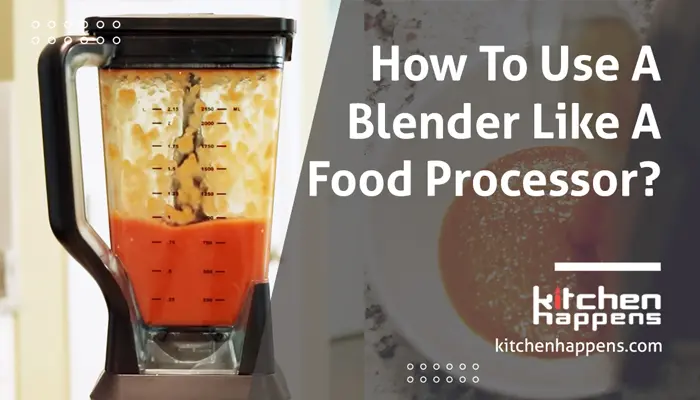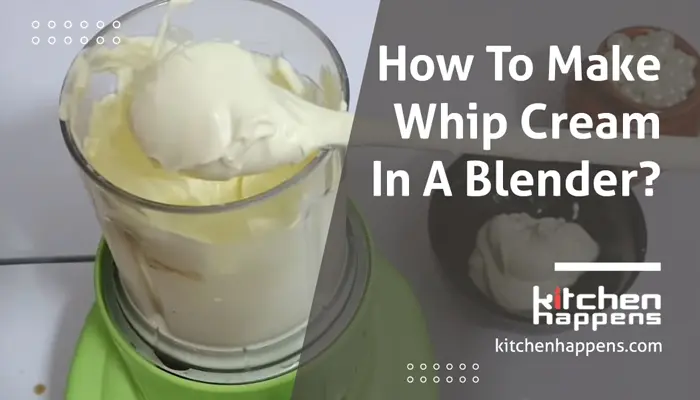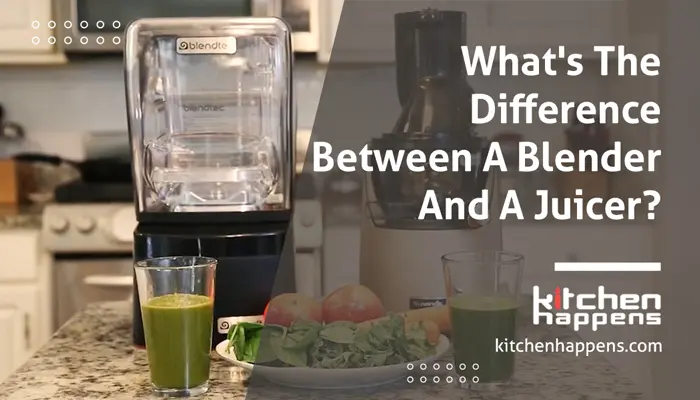Isn’t it great to get a 2-in-1 offer?
Of course, who doesn’t want such a deal?
Well, today, I have a similar idea to share with you, which is how to use a blender like a food processor.
Although they are different appliances, they have many similarities that make people wonder if they can use a blender instead of a food processor.
As I always like to work with different cooking equipment, I did the same to find out if these two can be used interchangeably. So, if you are curious to know how to do it, you are going to find the answer here.
Before I tell you the process, you need to know the working process of both of them as well as their differences. And my first segment will help you to learn that.
Food Processor Vs Blender: Learn The Key Differences
Here I will begin by explaining the working process of a blender.
Blender’s Functionalities
A blender contains powerful blades that rotate fast and blend a variety of food items like fruits, vegetables, nuts, and herbs.
Whether you want to make juice, puree, soups, or anything that involves liquid, a blender is the right choice. It is undoubtedly one of the most versatile kitchen equipment that can handle various cooking-related tasks.
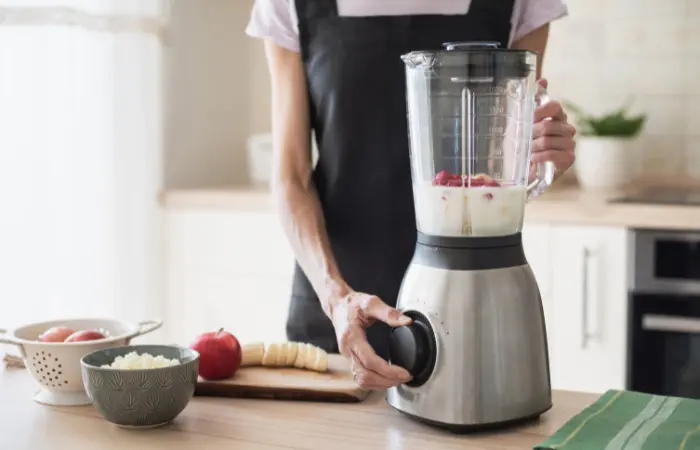
It has a base and a pitcher-like tall container on top of that. The jar is removable from the base for easy pouring.
A food blender has a few buttons or setting options that help you to select the speed. After pouring your ingredients into the jar, you can start to blend them and gradually increase the speed as per your need.
So, whether you want to blend them smoothly or want to have some pulps, you can do as your wish.
Okay, let’s move on to the food processor.
Food Processor’s Functionalities
A food processor is another common kitchen tool that uses spinning blades to cut food and requires very little liquid for mixing, slicing, dicing, and grating.
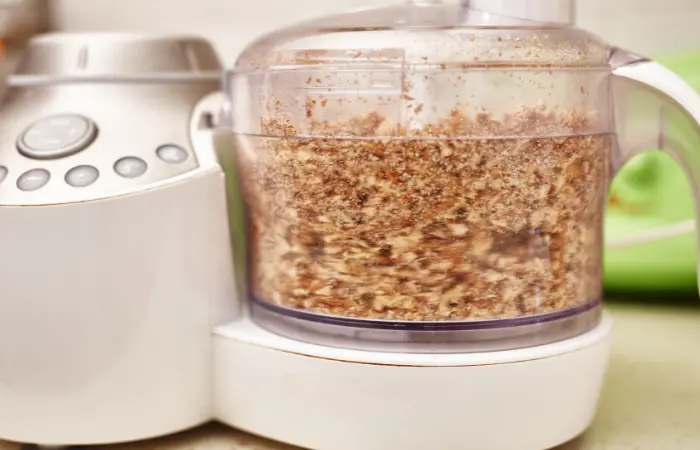
You can put the items, such as fruits, vegetables, herbs, etc., through a chute, and the razor-sharp blades will do the rest of the job.
Additionally, it can blend certain food items into salad dressing or sauces. That’s why it is a versatile appliance that helps you prepare quick meals.
Food processors are mainly available in three sizes: mini, compact, and full. The components include a bowl, lid, feed tube, and some other attachments.
And the motor is placed at the base. The strength of the motor depends on the processor’s size. The bigger the size, the stronger the motor will be.
While talking about the working process, you have to put food item through the feed tube and push it further with a plunger. It contains a shredding disc that quickly and effectively grinds materials like cheese, apples, and vegetables within a minute.
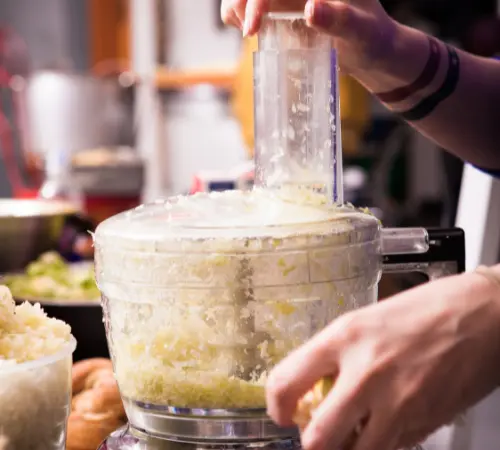
Now that you know how both of them work, can you point out the difference? It’s okay if you can’t as I am giving you the answer now.
What’s The Difference Between A Blender And A Food Processor?
One of the most significant differences is that a blender is used for mostly liquid foods, and a food processor is designed for
shortening various food preparation times.
Basically, if the final product will be something that you can drink, drizzle, or dip, then a blender is what you need. It can crush ice and puree fruits, vegetables, etc.
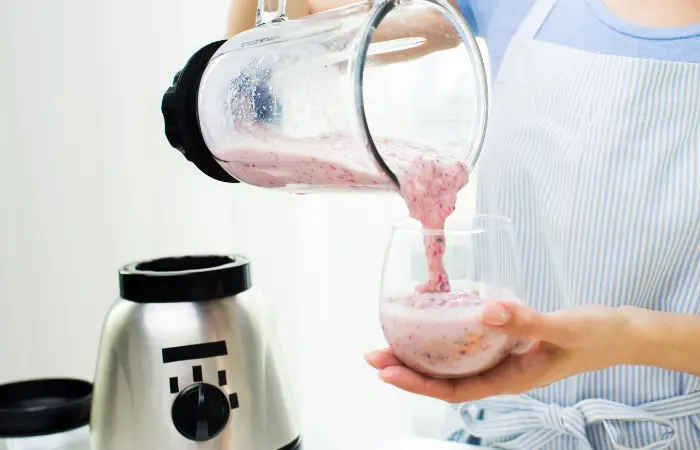
On the other side, a food processor is suitable when you need to slice, shred, grate, or chop your ingredients. Shortly, the outcome will be something that you can eat with a spoon or fork.
It can quickly process a variety of dry components but struggle with wet or liquid ones. It is helpful for both chopping veggies and mixing dough.
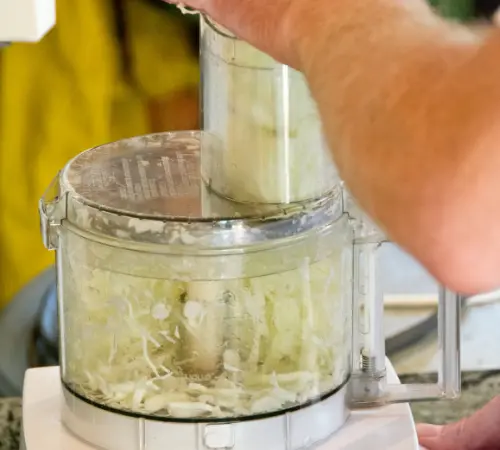
Which Is Best Depending on Various Food
For your better understanding, I am providing a table below which shows the recipe that can be prepared for the given appliances.
| Recipe/ Task | Blender | Food Processor |
| Sliced/ Minced Items | No | Yes |
| Shredded Cheese | No | Yes |
| Smoothie | Yes | No |
| Soup/ Puree/ Liquify | Yes | No |
| Crush Ice | Yes | No |
| Sauce | Yes | No |
| Dough | No | Appropriately |
| Butter | Appropriately | Yes |
| Dressing | Yes | Appropriately |
Till now, you have learned their differences. But, knowing their similarities will help you to take another step to understand whether you can use a blender alternatively to a food processor.
Similarities Between Food Processor & Blender
The setup of both appliances is quite similar.
Both blenders and food processors typically include a base-mounted motor. A jar or work bowl containing the blades or discs rests on this motor base.
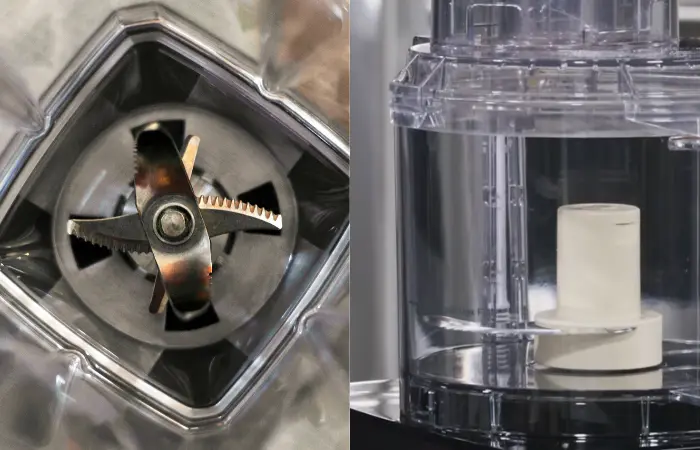
Although each appliance does specific jobs better than the others, you can switch the appliances for particular recipes.
And even there is some blender that can work like a food processor.
Check it out here.
Types of Blenders that Can Work As A Food Processor
Since the motor that power both of them are essentially the same, there is room for you to save money by opting for a combo model.
Yes, you heard me right.
For instance, you can prepare your preferred strawberry daiquiri, salsa salad, or hot butternut squash soup with the proper blender and food processor combination.
Blender Food Processor Combo
You will easily find a blender and food processor combo pair in the market.
Brands like Cuisinart, Ninja, Vitamix, and Oster offer the combo.
You have to pay a single fee for the Cuisinart and Ninja’s entire set (motor, blender jar, and food processor bowl).
Moreover, you can purchase the Oster’s blender separately or in combination with a food processor attachment.
And for the Vitamix food processor attachment is available for purchase separately.
Just pick the right model according to your need, and you are good to go.
But, if your blender can perform the food processor task, there is no need to spend money on the combo. So, finally, it’s time to learn the answer to the question: can a blender be used as a food processor?
Will A Blender Work Like A Food Processor?
The answer to this question isn’t quite that simple.
It actually depends on the dishes you intend to prepare. While blenders can carry out some of a food processor’s activities, a food processor ultimately has more accessories and is more versatile.
You already know that their work process is totally different.
When blenders create a vortex to drag chunks of food toward the blades and require liquid to crush them finely, the food processor works with dry ingredients to chop them.
As chopping is different from crushing, making a blender work like a food processor is hard.
Wait!! Wait!!
Don’t be disheartened. You can apply some tricks to do the task of food processors in a blender. Before I share the process, I would like to feed the curiosity of the mind that wonders if a food processor can be used as a blender.
Can You Use A Food Processor Like A Blender?
Unfortunately, food processors can’t handle liquids like a blender. And that’s why it’s impossible to make the smoothie, liquid sauce, or thin batter for creeps in a food processor.
In short, a food processor can’t be an alternative to a blender.
Okay, it’s the moment you were waiting for. I will now guide you on how do you use a blender like a food processor.
How to Use A Blender Like A Food Processor? Explore The Tricks & Tips!
Follow the below tricks, and you will be awarded a food processor-like result.
1. Use A Smaller Amount of Ingredients
While using a blender, you should process a smaller amount of ingredients rather than one large batch. I will advise you to put about half of what you typically use in a food processor.
You may increase the amount gradually as you go. This will provide a consistency similar to what a food processor can produce.
Remember that if you load too many ingredients into a blender, the food at the top will have a different texture from the bottom. It’s because there’s a chance that the food at the bottom will be overly processed.
So, putting food in a smaller batch will help to process the food evenly.
2. Blending Should Be Done Slowly
Blenders basically work at a higher speed compared to a food processor. Therefore, it might make your drink or food much more smoother than what you want it to be.
So, instead of letting the blender run for a long period of time, you can pulse it to simulate the power of a food processor.
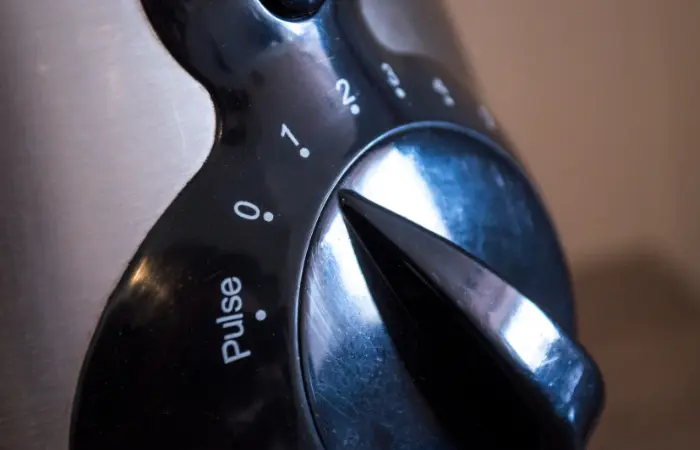
This way, you can stop when the food has the right texture you want rather than blend it smooth.
3. Use The Proper Settings
To control the blending operation, you have to adjust the settings. Depending on the blender model, there can be three or up to six-speed options.
First, you have to know your blender’s speed settings, meaning which speed can do how much blending. Try different settings and then get the correct speed according to your food.
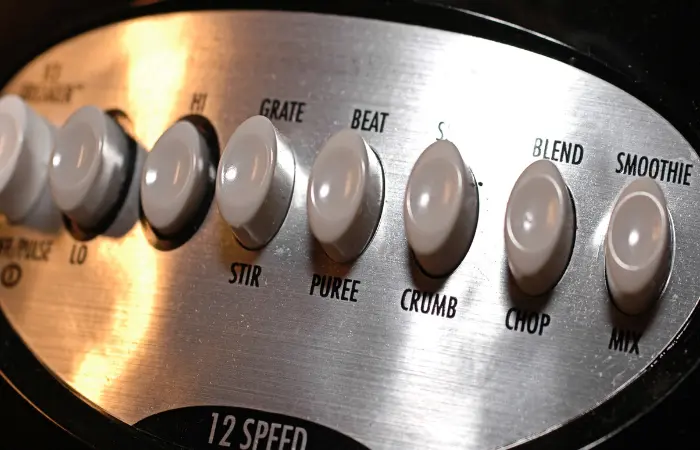
If you are going to chop ingredients, you may use the slowest speed.
Since it’s hard to get the right speed at once, I suggest you not pour all the ingredients at once. In this way, the waste will be less if things don’t work properly.
4. The Liquefy & Purée Settings Should Be Avoided
Blenders are made for liquefying liquids, chopping ice, and pureeing soups.
And the purpose of food processors is to combine and cut ingredients. Therefore, be careful not to chop food using the puree or liquefy option of your blender.
5. Reduce The Amount of Added Liquid
At the beginning of blending, you should use less liquid. It will help you replicate the work of food processors and won’t make your food soupy or watery.
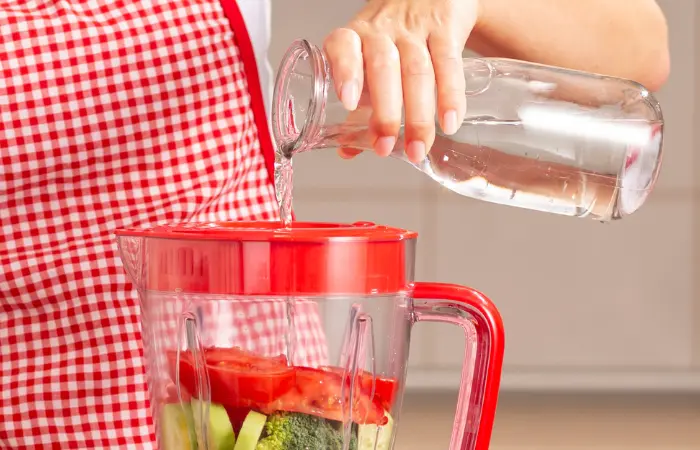
As you are using a blender, you always have the option of adding liquid as you go to make a smoother texture.
So, it’s best to use less liquid and adjust the amount when needed.
6. Important Tips
While blenders only have a single cutting tool to roughly mix or chop food, food processors feature a variety of equipment that can cut food into various sizes.
So, slicing, shredding, and grating food in the blender won’t be possible.
In case you are still confused about how to handle different food items in a blender, my next segment can help you out.
Using A Blender Instead of A Food Processor for Different Items
Before I explain the procedure for the different recipes or food items, I want to clarify that the final result won’t be as similar as the food processor. However, it will be much better than having no other option.
Okay, I will start with bread crumbs.
1. Bread Crumbs
First, cut up two or three slices of dried bread into quarters. Then place them into the blender jar. Keep processing the bread crumbs on a pulse till you get the desired size.
Now, in case your blender doesn’t have the pulse button, you may run the blender at high for 30 seconds at a time. Then repeat the same process with the remaining bread quarter.
HOMEMADE BREAD CRUMBS USING BLENDER – 2020
Based on the bread’s size, this will produce roughly 1/2 cup of breadcrumbs.
2. Baby Food
Making your own baby food is easy with a blender. Start by adding a quarter cup of freshly cooked veggies to the blender jar. Blend until smooth using the puree or high setting on the blender.
3. Shredded Cheese
As I previously stated, it is impossible to shred ingredients in a blender, just like a food processor. But, you can achieve a result to adjust with.
To grind or shred cheese, start by dicing hard cheese into 2 to 3-inch pieces.
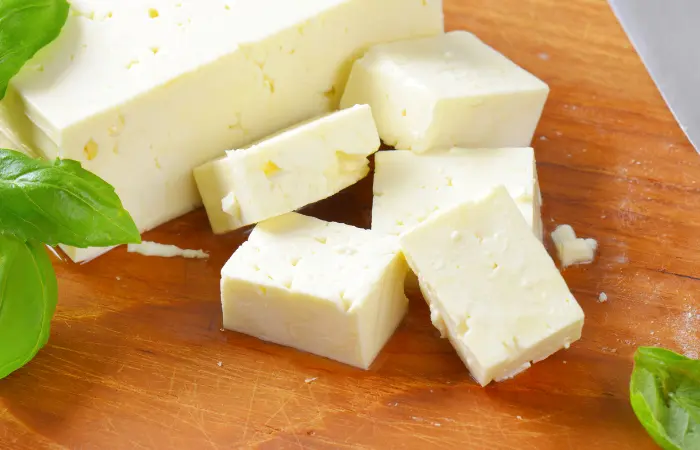
Place them inside the blender and blend for 30 seconds or until the cheese reaches the desired form.
4. Pesto
Put 2 cups of basil leaves, 3 minced garlic cloves, 3/4 cup Parmesan cheese, 3/4 cup extra virgin olive oil, and 1/4 cup pine nuts in the blender jar to make homemade pesto.
Blend on medium until the desired consistency is achieved.
5. Ice
Place four to five ice cubes in the blender jar to chop ice for mixed drinks. Blend at high speed until the cubes are chopped finely.
6. Important Notes
As you know that you have to work with small batches of food while using a blender rather than a food processor, it will be time-consuming.
But it is still worth doing all the tasks in a blender instead of using your hand.
Now here comes an important thing. Some blender models offer a food processor attachment that you can buy separately.
Check out if your blender model provides such offers. If yes, you can easily have the benefits of a food processor without spending much.
Alright, there are some functions of a food processor that, no matter what, a blender can’t do. And you need to know it before so that you don’t end up doing unnecessary hard work.
Food Processor Function That Blender Can’t Perform
Even though a blender can handle many tasks, there are still some kitchen jobs that it can’t do.
For example, a blender can’t be used if you want to knead a dough.
Moreover, the food processor has a slicing blade that is great for slicing vegetables like potatoes and making salads like cucumber and carrots. It provides even slices in seconds.
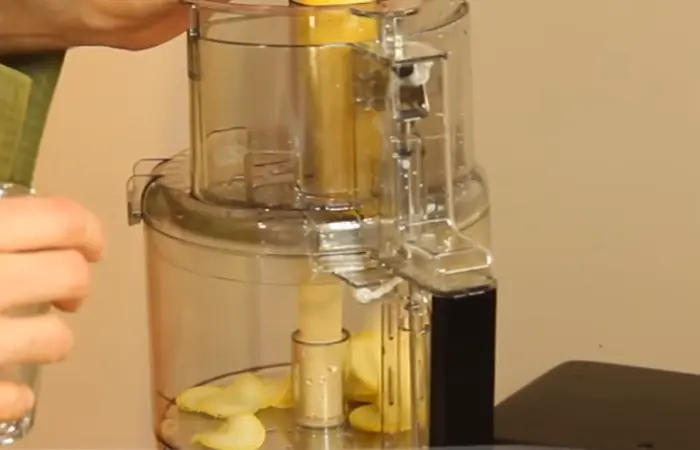
However, you can’t have this type of perfect piece of sliced food in a blender.
Large, wide pitchers in food processors allow for far larger blades than in blenders, making them excellent at crushing cookies into crumbs for a cheesecake base.
The blades are also perfect for grounding beef for handmade hamburgers.
So, these are some functions that food processors can perform thoroughly.
Now, besides the blender, is there another kitchen appliance that can be used in place of a food processor?
Let’s find out.
Things That Can Be Used Instead of A Food Processor
There are some other kitchen tools that can easily replace a food processor. And the options include:
- Chopper
- Mixer
- Grinder
- Rolling pin and a plastic bag
- Mortar and pestle
- And, of course, knives
Depending on the task you intend to do, you may choose one. For example, you can use a mixer when you need to mix ingredients like flour, butter, and milk to form a dough.
Vegetables, fruits, and meats can all be chopped or diced using knives. You can use a grater to mince or shred your items.
Except for knives, a grinder is also perfect for mincing meat finely.
Try using a grinder to produce nut butter. Although slightly heavier than food processors, they work pretty fine. You may also try using a mortar and pestle to grind without using a grinder.
For crushing foods like chips, cookies, and beans, you may use a resealable plastic bag. Just put the ingredients inside, and then use a rolling pin to crush the stuff inside.

Now, if you want to make purees and don’t have either a blender or food processor, then you can follow a trick. First, boil all the ingredients until they are soft. Then, you can easily mix or puree them with your hand.
What Should You Buy: Blender Or Food Processor?
Well, choosing between two of the most versatile kitchen appliances is kinda hard.
But, if you can make up your mind on what you intend to make, then you can quickly choose one.
Suppose you only plan to prepare the occasional dip or salsa; you will only need a food processor. It is able to make heavy doughs, grind meat, or slice vegetables. And blender can’t handle any of these tasks properly.
On the other hand, a blender is a suitable option if you are a smoothie lover or want to make soups or milkshakes with a smooth consistency. It is specially designed for these tasks, and the lids of the blender are usually leak proof. Whereas food processors often don’t come with a leak proof lid.
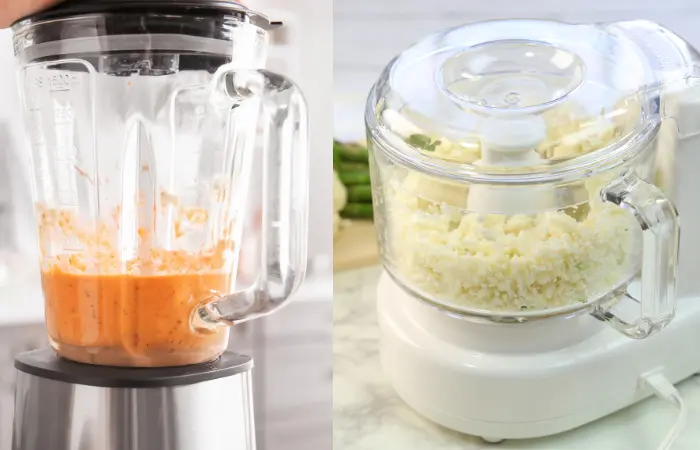
In short, what you should buy depends on your requirement for cooking.
Now, what to do if your cooking requirement needs both of them? Well, that’s where you will be stuck.
But, but, there’s a compromise, though!
As I said before, some blenders come with a food processor attachment that can perform many functions of a food processor. Therefore, if you are having trouble choosing between these two, a combo option might be your way out.
Is Buying A Food Processor Worth It?
If you have to prepare a lot of foods that involve mincing, chopping, or shredding, a food processor is worth buying. It will lower your preparation time.
Although these tasks can be done by hand, it will take 10 to 15 minutes or more, depending on the amount. In comparison, a food processor can chop within a minute.
Additionally, a food processor is safe for cooking. Put the vegetables or other items into your food processor instead of having to cut them up with a sharp knife. This prevents any blades from cutting into your fingers.
And there is no way you can’t appreciate the wide variety of things that a food processor can do. It is able to perform many things, from making dough and vegetable dishes to crushing graham crackers for pie crust and making bread crumbs.
So, is it worth purchasing? I already said that yes, it is. The decision is eventually up to you, though. I presented all their abilities, so just think of them and decide whether to get it or not.
Okay, as there is nothing left to discuss, I will wrap it up here.
Final Verdict
In this writing, you got to learn: can a blender be used like a food processor, how to use a blender like a food processor, tricks, essential tips, and many more.
Hopefully, it was a great help for you.
And lastly, I hope we will meet again through another writing. Till then, have a great time.
Frequently Asked Questions
Which is better to make salsa in a blender or food processor?
You may use a slow-speed food processor to create chunky salsa. This is so that you may create the desired texture with the various attachments that food processors have. Food processor-made salsas are less liquidy.
But, if you want finely chopped salsa with a puree-like consistency, you should opt for a high-speed blender.
So, which is better depends on your preference of texture.
Which is more expensive, a blender or a food processor?
A blender can cost between $40 to $600. In contrast, food processors’ prices range from $50 to $650.
So, a food processor is comparatively more expensive. It’s because it can perform multi-function compared to a blender.

